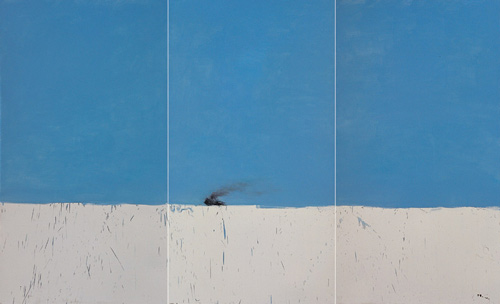DSL Collection: Legacy- ghostly manifestation in a new society
- julia_mji@me.com
- Jul 27, 2017
- 4 min read
Updated: Oct 16, 2023
Would love to share few more works from the gorgeous DSL collection by Sylvain and Dominique Levy.
The Chinese modernity is one intrinsically linked to revolution and to Marxism- Maoism; and the imagery and narratives, the legacy of this revolutionary modernity, constitute an important cultural pool from which Chinese artists of all generations draw inspiration until today. Its manifestations persist in the culture of the post-revolutionary and post-modern China.

Yan Lei
"Sometimes, I enjoy the excitement brought about by a matter of fortuity. 2006 is the year of the Dog in China. I happened to see some images of Cao Fei's work where men were dressed up as dogs, behaving stupidly docile. Sotheby's also organized the biggest Chinese contemporary art auction ever. These few events collided I combined them in one painting and called it New York, Dog Year."

WANG XINGWEI
The composition of this work clearly recalls Cheng Conglin's "A Snowy Day in 1968", a now iconic work from the "Scar Painting" movement (1979-82), which aspired to turn the then-popular Socialist Realist style back onto itself, highlighting the destruction left by the previous decades. The "No U-turn" signs that are strategically placed around the picture plane refer to the ground-breaking exhibition, "Create History: Commemoration Exhibition of Chinese Modern Art in 1980s" held at the National Gallery. At the time, the "No U-turn" sign represented a symbol of the new China trying to burst out from the old one. There was no turning back, as the sign implied.

Li Dafang
Li sees himself as a director, composing mildly absurd scenes with realistic backgrounds and human figures performing unusual tasks. To Li, a work's subject, title and imagery form an inseparable whole. This is exemplified in "Twang", a work that can only be understood knowing the story behind it. It is about two friends who lived far away from each other and kept in touch by playing the Chinese zither, guqin. The caption reads “Kang Qi come over” “I don’t know”. Kang has been the given name of Xi Kang, a famous musician of the fourth century and author of a long poem on the guqin. The story is also reminiscent of a Chinese historical myth about music and friendship (Yu Boya and Zhong Zhiqi). Unlike Li's other paintings, which are clearly located in the present, "Twang" is timeless. What one sees could happen anytime anywhere. It is a perfect example of the working style of Li, who alludes to legends to communicate his complex semi-real inner world, while at the same time offering the viewer a space of his own within this world.
Twang Painting. Oil on canvas. 300 x 480cm. 2003.

JIA AILI
Jia wants viewers to step out of their worlds for a moment and to feel the anguish and isolation that engulfs his painted world. This desire accounts for the enormous scale of his paintings, which ultimately draws viewers close to the solitary soul that Jia inserts in the vast landmasses that set the stage for his synoptic psychological dramas. In this work, "Untitled", a forlorn figure stands with his head bowed low in front of a giant propeller, which is partly stripped of its outer casing. This could be read with reference to the cold, social landscape of Shenyang (where Jia lives and works), where most of its local steel plants and heavy industry factories were forced to close during the 1980s and 90s. Set against a cold, grey background reminiscent of an abandoned hangar, the lone "shadow" of a figure, depicted with soft, painterly brushstrokes, appears even more insignificant.
After two years of painting and re- painting, Jia's five-panel monumental masterpiece is as close to being finished as it'll ever be. Images of industrial debris and lone figures, recalling the global powers' space exploration programmes of the 1980s, capture moments of solitude that are ambiguously filled with regret and hope. His subdued palette of grey and blue hues conveys lonely moments felt at the end of a day or even an era. Indeed, the scene appears to be the aftermath of some disastrous event. As the title implies, this is a work aimed at capturing the understanding of our time through the eyes of a hopeful pioneer ready to explore, or even create, a beginning of a new world, our century.
ZENG FANZHI
Although less recognised than his iconic Mask paintings, the "We" series (2002) is perhaps of even greater historical significance, both aesthetically and culturally. This series, of which "We no. 8" is a part, marks a critical turning point in Zeng’s artistic development. Using two or more brushes at once, Zeng simultaneously “creates and yet destroys.” What truly distinguishes this series is its timelessness – the works are very much “of the moment” but at the same time, they exist beyond the present.
Information respectfully taken from DSL Collection - Chinese Contemporary 2005.
To learn more about this gorgeous collection please visit: http://www.g1expo.com/v3/dslcollection/


















